If you’re torn between getting a Husky or an Australian Shepherd as your furry friend, this guide will help you make an informed decision. Huskies and Australian Shepherds are both popular dog breeds, each with their own unique characteristics and temperaments. It’s essential to understand the differences between these breeds to determine which one is right for you.
When choosing between a Husky and an Australian Shepherd, it’s crucial to consider your lifestyle and preferences. Both breeds require dedicated owners who can provide the necessary care and attention. Researching reputable breeders is key to ensuring you bring home a healthy and well-bred pup.
Socialization and training are vital for both Huskies and Australian Shepherds. These breeds thrive on exercise and mental stimulation, so be prepared to meet their high energy needs. Australian Shepherds have a keen herding instinct, while Huskies have a strong prey drive, which should be managed and understood.
Whether you’re looking for a winter-loving companion or an intelligent and versatile dog, Huskies and Australian Shepherds can both make great additions to your family. Take the time to evaluate their unique characteristics, exercise requirements, grooming needs, and temperaments to make an educated decision.
This guide will help you navigate the differences between Huskies and Australian Shepherds, empowering you to find your perfect pet pal. Remember, no matter which breed you choose, providing a loving and nurturing environment is essential for a happy and healthy dog.
Unraveling the Unique Characteristics
Huskies and Australian Shepherds possess distinct and fascinating characteristics that set them apart from each other. In terms of physical characteristics, Huskies are well-known for their striking appearance, with their thick double coat, erect ears, and piercing blue or multi-colored eyes. They have a strong and muscular build, designed to withstand harsh winter conditions. On the other hand, Australian Shepherds have a medium-sized, compact body with a weather-resistant coat that comes in various colors and patterns. Their almond-shaped eyes exude intelligence and curiosity.
When it comes to temperament, Huskies are independent and strong-willed, often displaying a touch of stubbornness. They are known for their friendly and gentle nature, making them good family pets. Australian Shepherds, on the other hand, are highly intelligent and versatile. They are eager to please and are often described as highly trainable. Their loyal and loving nature makes them great companions for active individuals or families.

It’s important to note that while Huskies may have a more independent streak, both breeds require socialization and training from an early age to ensure they become well-rounded and well-behaved companions.
In summary, Huskies and Australian Shepherds have unique physical and temperament traits that make them special. While Huskies are known for their striking appearance and independent nature, Australian Shepherds showcase their intelligence and versatility. When considering these breeds, it is crucial to research reputable breeders and consider your lifestyle and the specific needs of each breed. Both breeds require dedicated owners who can provide the necessary care, exercise, and mental stimulation for a happy and healthy life together.
Understanding Temperament Differences
While both Huskies and Australian Shepherds make wonderful companions, their temperaments differ significantly. Understanding these differences is essential when choosing the right breed for your lifestyle and preferences.
Huskies are known for their independent and free-spirited nature. They are intelligent, social, and have a strong sense of adventure. However, their independent streak can make them challenging to train. Huskies are also known for their friendly and affectionate nature, making them great family pets.
Australian Shepherds, on the other hand, are highly intelligent and eager to please. They are loyal, trainable, and excel at obedience and agility training. Australian Shepherds are also known for their protective instincts, making them excellent watchdogs. They are energetic and require plenty of mental and physical stimulation to thrive.
Table: Temperament Comparison
| Breed | Temperament |
|---|---|
| Husky | Independent, adventurous, friendly |
| Australian Shepherd | Intelligent, trainable, loyal, protective |
When considering a Husky or an Australian Shepherd, it is important to assess your own lifestyle and preferences. If you are an active individual who enjoys outdoor activities and has plenty of time to invest in training, the Husky’s adventurous spirit may be a good match for you. On the other hand, if you are looking for a highly trainable and obedient companion, the Australian Shepherd’s eagerness to please may be more suitable.
Regardless of your choice, both breeds require socialization, mental stimulation, and regular exercise to prevent boredom and destructive behaviors. It is crucial to provide proper care and attention to ensure the happiness and well-being of your furry friend.
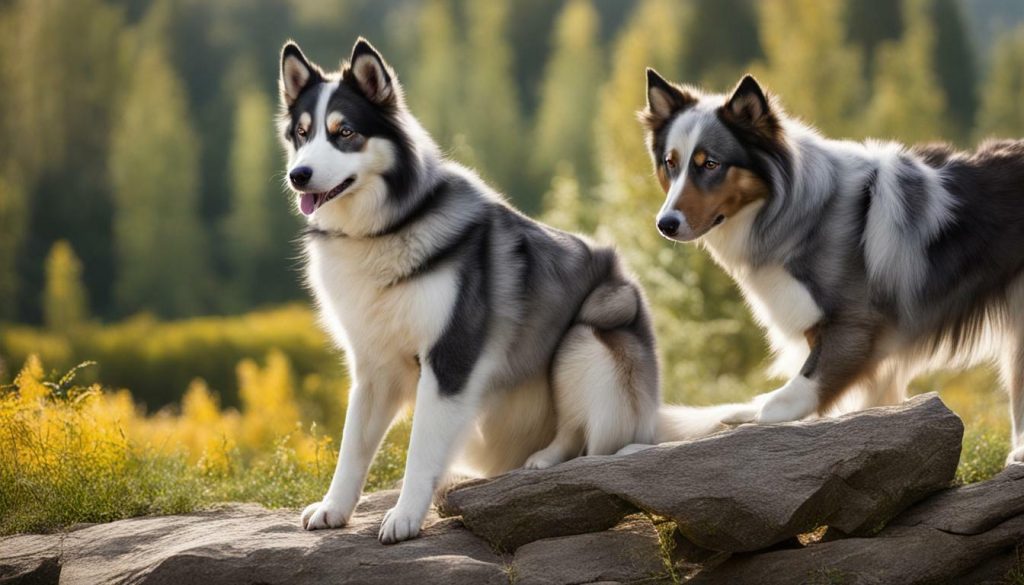
In summary, Huskies and Australian Shepherds have distinct temperaments that require understanding and consideration. By researching reputable breeders and taking into account your own lifestyle and preferences, you can make an informed decision and find the perfect companion for your family.
Meeting Exercise Needs
Both Huskies and Australian Shepherds thrive on regular exercise and require plenty of physical activity to stay happy and healthy. These breeds have high energy levels and excel in activities that challenge their minds and bodies. Providing adequate exercise not only helps prevent behavioral problems but also strengthens your bond with your furry companion.
Australian Shepherds, often referred to as “Aussies,” are athletic and versatile dogs that love to engage in various activities. They enjoy long walks, hiking, jogging, and playing fetch. Their intelligence and agility make them excellent candidates for dog sports such as agility trials and obedience competitions. Aussies require around 60 minutes of exercise per day to meet their needs.
Huskies, on the other hand, are known for their endurance and ability to pull sleds in freezing conditions. These majestic dogs have a strong desire to run, and a fenced-in yard or a safe, open space is essential for them. Huskies require at least 90 minutes to 2 hours of exercise every day to burn off their abundant energy. Engaging them in activities like running, biking, or dog sledding will help keep them physically and mentally stimulated.
Tips for Exercising Your Husky or Australian Shepherd:
- Create a routine: Establish a consistent exercise schedule to keep your dog’s energy levels balanced and prevent restlessness.
- Mix it up: Provide a variety of activities to keep your dog engaged and prevent boredom. This can include walks, runs, hikes, and interactive play sessions.
- Consider dog sports: Engaging in activities like agility training, obedience trials, or flyball can help challenge your dog’s mind and provide them with a sense of accomplishment.
- Provide mental stimulation: Combine physical exercise with mental stimulation through puzzle toys, obedience training, or scent work. Keeping your dog mentally stimulated is just as important as physical exercise.
- Allow socialization: Regularly expose your dog to different environments, people, and other animals to encourage socialization skills and a well-rounded temperament.
Remember, exercise needs may vary among individual dogs, so it’s important to observe your pet’s behavior and adjust their exercise routine accordingly. Providing the right amount of physical activity and mental stimulation will contribute to a happy and healthy life for your Husky or Australian Shepherd.
| Husky | Australian Shepherd | |
|---|---|---|
| Exercise Duration | 90 minutes – 2 hours per day | Around 60 minutes per day |
| Ideal Activities | Running, biking, dog sledding | Long walks, hiking, agility trials, obedience competitions |
| Exercise Intensity | High | Moderate to high |
“A tired dog is a happy dog, and both Huskies and Australian Shepherds thrive when they have plenty of opportunities to burn off their energy.”
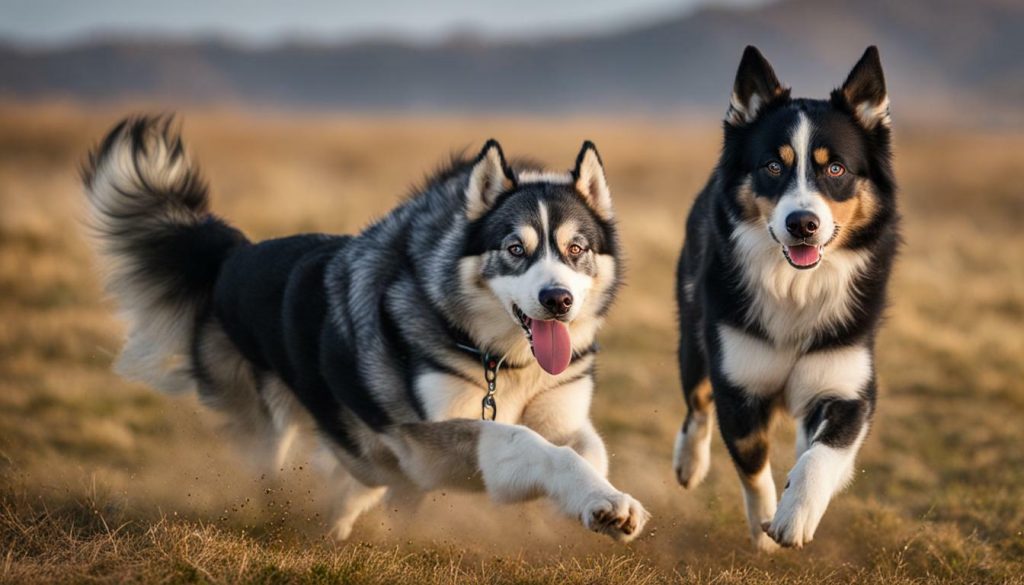
Providing ample exercise for your Husky or Australian Shepherd is essential to their overall well-being. Regular physical activity not only keeps them physically fit but also helps fulfill their natural instincts and prevents destructive behaviors. So lace up your sneakers, grab a leash, and embark on an adventure-filled journey with your energetic companion.
Managing Grooming Requirements
Keeping both Huskies and Australian Shepherds well-groomed is essential, but their specific grooming requirements differ. Huskies have a thick double coat that requires regular brushing to prevent matting and to keep their fur clean and healthy. They shed heavily twice a year, a phenomenon known as “blowing coat,” during which they shed their undercoat in large amounts. This shedding period requires increased grooming to manage the excess fur. On the other hand, Australian Shepherds have a medium-length double coat that also requires regular brushing to prevent tangles and remove loose hairs.
While both breeds benefit from regular brushing, it is important to note that Australian Shepherds may require more frequent brushing, especially during shedding seasons. Additionally, Huskies are known for their self-cleaning nature, and bathing should be kept to a minimum to preserve their skin’s natural oils. Australian Shepherds, however, may require more regular bathing to keep their coat clean and odor-free.
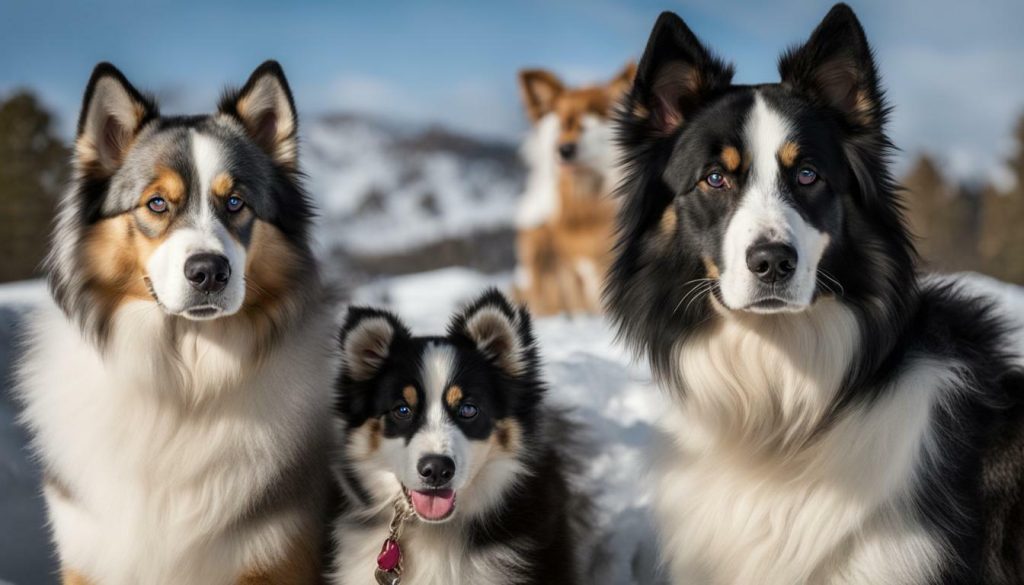
To maintain their overall appearance, both breeds need regular nail trims and ear cleaning. Dental care is also crucial for their oral health. Regular teeth brushing and professional dental cleanings, as recommended by your veterinarian, can help prevent dental issues.
| Grooming Requirements | Husky | Australian Shepherd |
|---|---|---|
| Coat Type | Thick double coat, heavy shedding twice a year | Medium-length double coat, moderate shedding |
| Brushing Frequency | Regular brushing, increased during shedding periods | Regular brushing, may require more frequent brushing during shedding seasons |
| Bathing Frequency | Minimal bathing to preserve natural oils | Regular bathing to keep coat clean and odor-free |
| Nail Trimming | Regular nail trims | Regular nail trims |
| Ear Cleaning | Regular ear cleaning | Regular ear cleaning |
| Dental Care | Regular teeth brushing and professional dental cleanings | Regular teeth brushing and professional dental cleanings |
Remember, grooming is not only about maintaining your dog’s appearance but also about promoting their overall health and well-being. Consulting with a professional groomer or your veterinarian can provide further guidance on maintaining the best grooming routine for your Husky or Australian Shepherd.
Training Differences
Training Huskies and Australian Shepherds requires understanding and adapting to their unique learning styles and behavioral traits. These two breeds have distinct characteristics that can affect their training process. Huskies, known for their independent nature, may display a stubborn streak and require consistent and patient training methods. On the other hand, Australian Shepherds, renowned for their intelligence and eagerness to please, excel in obedience training and thrive when mentally stimulated.
When training a Husky, it is crucial to establish a strong leadership role and use positive reinforcement techniques. Their innate desire for social interaction and tendency to explore may make recall training challenging. Consistency, firmness, and positive reinforcement are keys to training success with Huskies.
Australian Shepherds, with their high intelligence and intense focus, excel in various training disciplines such as agility, obedience, and even herding. Positive reinforcement, along with mental and physical stimulation, is crucial to keep them engaged during training sessions. They thrive when given tasks and enjoy problem-solving, making them quick learners.
Expert Tip
“To maximize training success with both Huskies and Australian Shepherds, it is recommended to start training from an early age. Early socialization is key to prevent behavior issues and ensure they grow into well-rounded adult dogs. Remember to keep training sessions fun, short, and rewarding, as both breeds respond best to positive reinforcement and praise.”
| Training Differences | Huskies | Australian Shepherds |
|---|---|---|
| Learning Style | Independent and may be stubborn | Intelligent and eager to please |
| Training Approach | Consistent, firm, and positive reinforcement | Positive reinforcement, mental stimulation, and problem-solving tasks |
| Recommended Training Age | Early socialization and training from puppyhood | Early socialization and training from puppyhood |
Understanding these training differences is essential for prospective owners considering either a Husky or an Australian Shepherd. Training is a vital aspect of their overall well-being and can significantly impact the bond between owner and dog. By tailoring training methods to suit the unique characteristics of each breed, you can set your furry friend up for success and create a harmonious and fulfilling relationship.
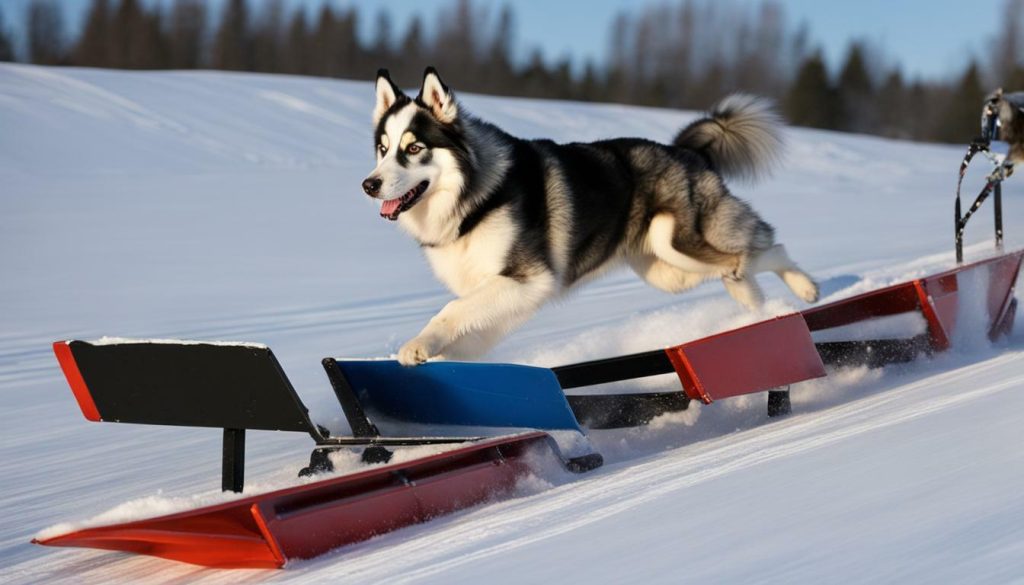
If you’re looking for the perfect furry companion for your family, both Huskies and Australian Shepherds have qualities that make them great choices. These breeds are known for their loyalty, affectionate nature, and ability to bond with their human families. However, there are some important factors to consider when deciding which breed is the best fit for your family’s lifestyle and needs.
Australian Shepherds are highly intelligent and versatile dogs. They are often referred to as “velcro dogs” because of their strong desire to be by their owner’s side. This breed thrives on human companionship and excels in activities such as obedience training, agility, and even search and rescue. Australian Shepherds are energetic and require regular exercise to stay happy and healthy.
Huskies, on the other hand, are known for their striking appearance and endurance in cold climates. These dogs have a strong pack mentality and are known escape artists, requiring secure fencing and supervised outdoor time. Huskies are social by nature and enjoy the company of their family, but they can also be independent and stubborn. They require consistent training and mental stimulation to prevent boredom and destructive behavior.
| Husky | Australian Shepherd | |
|---|---|---|
| Temperament | Independent, stubborn | Loyal, versatile |
| Exercise Needs | High, requires mental and physical stimulation | High, thrives on regular exercise and activities |
| Herding Abilities | Minimal | Exceptional, excels in herding activities |
| Prey Drive | High | Moderate |
“Both Huskies and Australian Shepherds can be wonderful family pets, but they require dedicated owners who can meet their specific needs.”
“When considering which breed is the best fit for your family, it’s important to research reputable breeders who prioritize health and temperament. Additionally, proper socialization and training from a young age are essential for both breeds to ensure they become well-rounded and obedient companions.”
Overall, both Huskies and Australian Shepherds have the potential to make fantastic family pets. However, it is crucial to understand the unique characteristics and requirements of each breed before making a decision. Whether you choose a Husky or an Australian Shepherd, providing a loving and dedicated home will ensure a joyful and fulfilling relationship with your new furry friend.
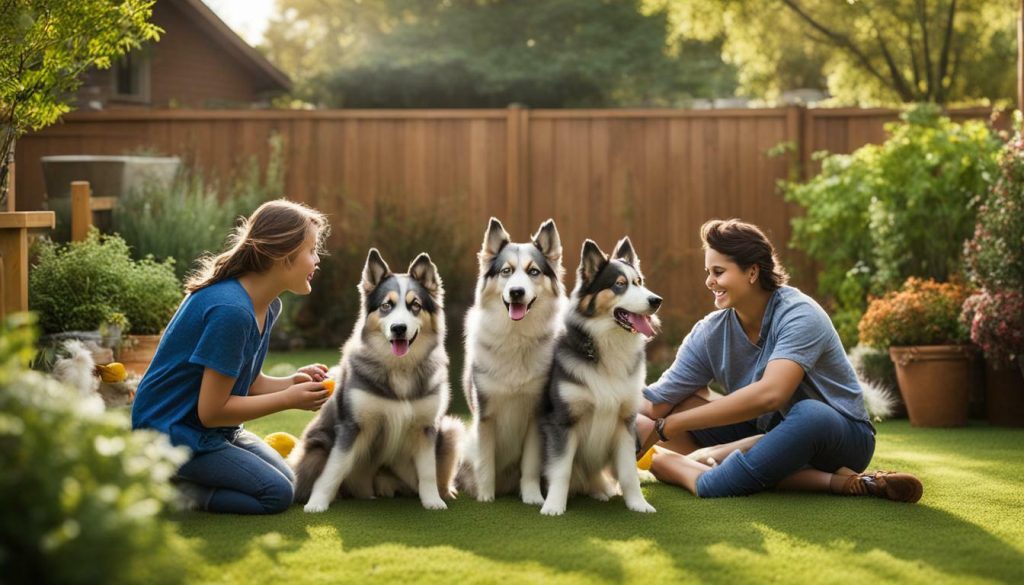
Australian Shepherds possess remarkable herding instincts and excel in working environments, unlike Huskies. These intelligent and agile dogs were bred to work alongside farmers and ranchers, herding livestock with precision and efficiency. Their herding abilities are unparalleled, and they have a natural instinct to round up and control the movement of animals. With their sharp focus, quick reflexes, and excellent problem-solving skills, Australian Shepherds are highly valued for their work ethic and adaptability in various herding situations.
| Herding Abilities | Australian Shepherd | Husky |
|---|---|---|
| Instinctual Herding Capability | Excellent | Minimal |
| Working Environments | Adaptable | Not suitable for herding |
| Problem-solving Skills | Highly developed | Not emphasized |
| Livestock Control | Precision and control | Less focus on herding |
“Australian Shepherds are natural-born herders. Their ability to quickly assess situations and make split-second decisions allows them to effectively move livestock, respond to commands, and navigate challenging terrains. Their versatile herding skills are truly remarkable.” – Professional Dog Trainer
On the other hand, Huskies were originally bred as sled dogs, emphasizing their endurance and pulling power rather than herding capabilities. While Huskies may have some instinctual herding tendencies, it is not their primary purpose or area of expertise. Their focus and drive are more centered around pulling sleds and working in cold weather conditions, making them better suited for activities such as mushing and sledding.
It’s important to note that while Australian Shepherds excel in herding, it doesn’t mean they can’t be wonderful companions outside of a working environment. With proper training, socialization, and mental stimulation, Australian Shepherds can adapt to various lifestyles and make loving family pets. Their herding instincts, however, should be taken into consideration when deciding to bring them into a non-working household.
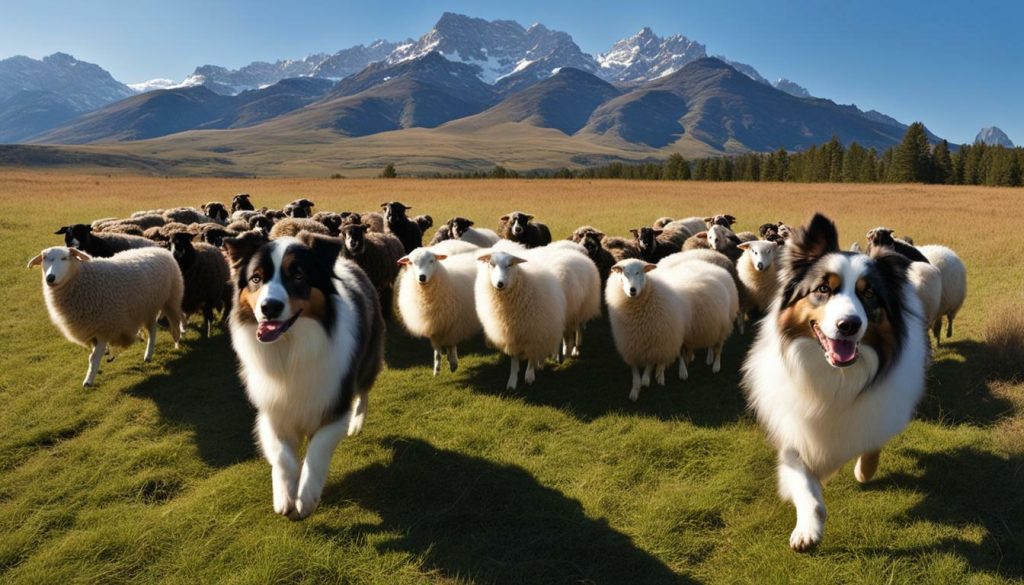
Australian Shepherds possess remarkable herding instincts and excel in working environments, unlike Huskies. These intelligent and agile dogs were bred to work alongside farmers and ranchers, demonstrating their natural ability to round up and control the movement of livestock. Australian Shepherds exhibit excellent problem-solving skills, adaptability to various herding situations, and precision in livestock control. Huskies, on the other hand, were primarily bred as sled dogs, emphasizing their endurance and pulling power rather than herding capabilities. While they may have some instinctual herding tendencies, it is not their primary purpose or area of expertise. When considering a dog for herding purposes, Australian Shepherds are the breed that excels in this field.
Assessing Prey Drive
While both Huskies and Australian Shepherds have their unique drives, their prey drive differs considerably. Prey drive refers to a dog’s instinctual desire to chase and capture prey, whether it’s small animals, birds, or even toys. Understanding the prey drive of each breed is crucial when considering them as potential companions.
Huskies, known for their sled-pulling heritage, have a strong prey drive. This is rooted in their history as working dogs in harsh Arctic environments, where they had to hunt for survival. Their instinct to chase after small animals can be attributed to this natural drive. It’s important to note that Huskies have a high energy level and need significant mental and physical stimulation to prevent boredom and destructive behaviors.
Australian Shepherds, on the other hand, have a moderate prey drive. While they possess herding instincts, their drive to chase and capture prey may not be as strong as that of Huskies. However, it’s essential to provide them with ample exercise and mental stimulation, as Australian Shepherds are intelligent and active dogs. They thrive in environments where they can use their natural instincts, whether it’s herding livestock or participating in dog sports.
| Husky | Australian Shepherd | |
|---|---|---|
| Prey Drive | High | Moderate |
| Exercise Needs | High | High |
| Temperament | Independent, strong-willed | Intelligent, versatile |
Understanding and managing the prey drive of your chosen breed is crucial, especially if you have other pets or small animals in your household. It’s important to provide proper training, socialization, and a safe environment to ensure the well-being of both your dog and other animals. Remember, every dog is an individual, and while breed tendencies can guide us, it’s essential to assess each dog’s behavior and needs on an individual basis.
By considering the prey drive, exercise needs, and overall temperament of Huskies and Australian Shepherds, you can make an informed decision when choosing your perfect pet companion. Each breed has its unique qualities, and it’s important to match those qualities with your lifestyle and preferences. Whether you’re seeking a loyal and energetic adventure buddy or a versatile and intelligent working dog, both Huskies and Australian Shepherds can make wonderful additions to the right home.
Dedicated Care and Attention
Both Huskies and Australian Shepherds thrive when they have dedicated owners who can provide them with the care and attention they deserve. These breeds require more than just food and shelter; they need an active lifestyle, mental stimulation, and socialization to truly flourish.
Huskies are known for their endurance and ability to pull sleds in cold climates. They have a thick double coat that requires regular brushing to prevent matting and shedding. In addition to physical exercise, Huskies need mental stimulation to prevent boredom, as they are intelligent and independent by nature. Training and socialization from an early age are essential to manage their strong prey drive and maintain good behavior.
Australian Shepherds, on the other hand, are highly versatile and intelligent dogs that excel in various activities, including herding, obedience, and agility. They have a medium-length double coat that requires regular brushing to prevent tangling and matting. With their high energy levels, Australian Shepherds need plenty of exercise and mental stimulation to prevent destructive behavior. In addition to physical exercise, they thrive on tasks and enjoy learning new tricks.
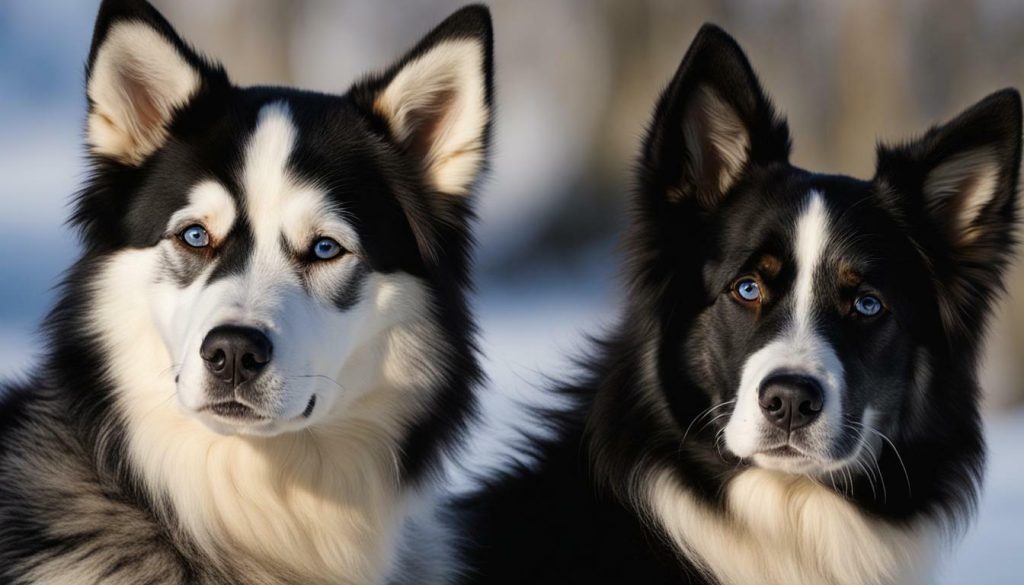
Both Huskies and Australian Shepherds require a dedicated owner who can commit to their specific needs. This means providing daily exercise, mental stimulation, and socialization. It also means investing time and effort into training and establishing boundaries to ensure both breeds are well-behaved and well-adjusted.
In summary, Huskies and Australian Shepherds are both wonderful breeds that can make great companions. However, they require dedicated owners who can meet their unique needs. Whether you choose a Husky or an Australian Shepherd, be prepared to invest time, energy, and love into your furry friend, and you will be rewarded with a loyal and loving companion.
Choosing Your Perfect Pet Pal
Choosing between a Husky and an Australian Shepherd requires careful consideration of various factors, and this section will help you make an informed decision. Both breeds have their own unique characteristics and temperaments, so it’s important to understand their needs and compatibility with your lifestyle.
Huskies are known for their ability to thrive in winter conditions, with their thick double coat providing insulation against the cold. They are also known for their striking blue or multi-colored eyes, which add to their allure. Australian Shepherds, on the other hand, are versatile and intelligent dogs, excelling in various tasks such as herding, agility, and obedience competitions.
Socializing and training are crucial for both Huskies and Australian Shepherds. These breeds require a lot of exercise and mental stimulation to keep them happy and healthy. Huskies, being sled dogs, have a high energy level and need plenty of physical activity. Australian Shepherds, with their herding background, have a strong work ethic and benefit from engaging in activities that tap into their innate drive.
Ultimately, the choice between a Husky and an Australian Shepherd comes down to your personal preferences and lifestyle. Consider factors such as your living situation, activity level, and the time and effort you can dedicate to training and exercising your potential pet. Both breeds make great companions but require dedicated owners who can provide the necessary care and attention they deserve.
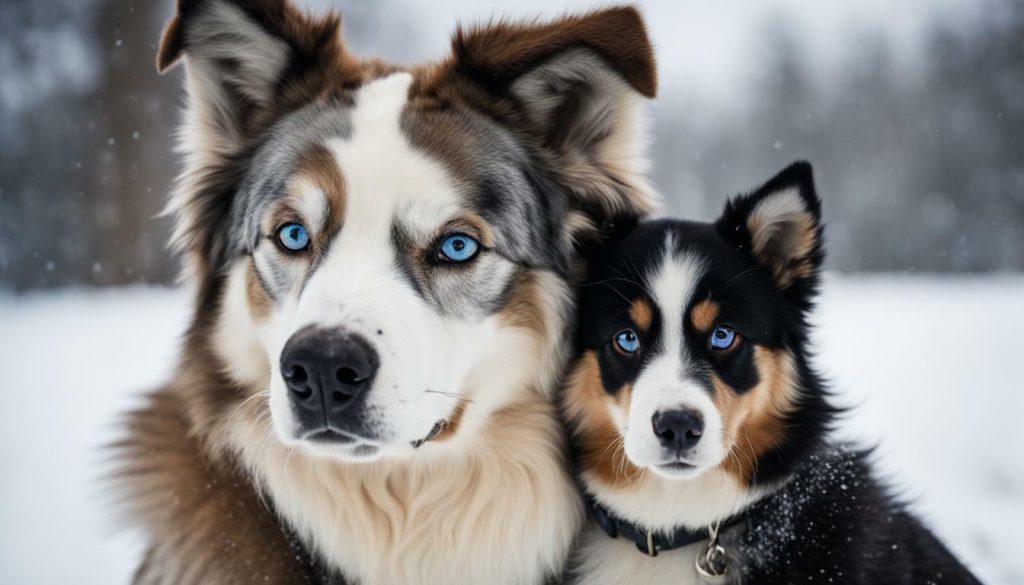
| Factors to Consider | Husky | Australian Shepherd |
|---|---|---|
| Temperament | Independent, strong-willed | Intelligent, eager to please |
| Exercise Needs | High energy, requires vigorous exercise | High energy, needs mental and physical stimulation |
| Grooming Requirements | Requires regular brushing, sheds seasonally | Needs regular brushing, sheds moderately |
| Training | Can be stubborn, needs firm and consistent training | Quick learners, benefits from positive reinforcement |
| Herding Abilities | Not known for herding instincts | Exceptional herding skills |
| Prey Drive | Strong prey drive, may not do well with small animals | Varies, but generally less intense prey drive |
Find your Match Today!
Now that you have a better understanding of Huskies and Australian Shepherds, it’s time to find your perfect match and embark on a rewarding journey with your new furry friend.
When choosing between these two popular dog breeds, it is crucial to research reputable breeders who prioritize the health and well-being of their dogs. Responsible breeders will provide you with valuable information about the breed’s lineage, temperament, and any potential health issues to be aware of.
Both Huskies and Australian Shepherds require dedicated owners who can meet their specific needs. These breeds thrive with plenty of exercise and mental stimulation, so make sure you have the time and energy to provide them with the physical activities they crave.
Consider your lifestyle and preferences when deciding on a breed. If you are an active individual or have an outdoorsy lifestyle, the energetic and independent nature of an Australian Shepherd might be a great fit. On the other hand, if you live in a colder climate and enjoy brisk winter walks, the endurance and resilience of a Husky could be the ideal companion for you.
Remember, both breeds require socialization and training from an early age to ensure well-rounded and obedient behavior. If you are willing to put in the effort and commitment, Huskies and Australian Shepherds can bring immense joy and love into your life.
FAQ
Q: Where can I find reputable breeders for Huskies and Australian Shepherds?
A: It is recommended to research and find reputable breeders through national or local breed clubs, as well as online platforms that specialize in connecting potential owners with responsible breeders.
Q: Do Huskies and Australian Shepherds have specific health concerns?
A: Both breeds may be prone to certain health issues. It is important to consult with a veterinarian and choose a breeder who conducts health screenings on their breeding dogs to reduce the risk of inherited health problems.
Q: Are Huskies and Australian Shepherds good for families with children?
A: Both breeds can be good family dogs, but it is important to consider the specific needs and temperaments of each breed. Proper socialization and training are crucial for any dog to ensure they are comfortable and well-behaved around children.
Q: How much exercise do Huskies and Australian Shepherds need?
A: Both Huskies and Australian Shepherds are active breeds that require plenty of exercise. They thrive with daily mental and physical stimulation, including long walks, playtime, and engaging activities.
Q: Do Huskies and Australian Shepherds shed a lot?
A: Yes, both breeds are known for their heavy shedding. Regular grooming and brushing are necessary to manage their coat and minimize shedding in the home.
Q: Are Huskies and Australian Shepherds easy to train?
A: Australian Shepherds are generally easier to train due to their intelligence and eagerness to please. Huskies, on the other hand, can be more independent and stubborn, requiring consistent and patient training methods.
Q: Can Australian Shepherds be used for herding?
A: Yes, Australian Shepherds are renowned for their herding abilities. They excel in activities such as herding trials, agility, and obedience competitions.
Q: Do Huskies have a strong prey drive?
A: Yes, Huskies have a strong prey drive rooted in their origin as sled dogs. It is important to provide proper training and supervision to manage their instinctual behaviors.
Q: How much time and attention do Huskies and Australian Shepherds require?
A: Both breeds require dedicated owners who can provide ample time, attention, and mental stimulation. They thrive in active households where they can be part of the family’s daily routine.
Q: How can I choose between a Husky and an Australian Shepherd?
A: To make an informed decision, consider your lifestyle, energy level, and preferences. Research the breed characteristics, talk to owners and breeders, and spend time with both breeds to see which one aligns better with your needs and expectations.
Q: Where can I find Huskies or Australian Shepherds available for adoption?
A: You can consider checking local animal shelters or rescue organizations that specialize in Huskies or Australian Shepherds. They may have dogs of these breeds available for adoption.
